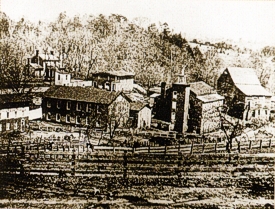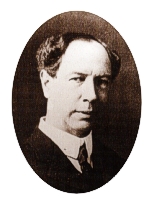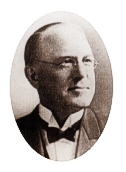 This information is taken from the following publication
of the American Chemical Society, Division of the History of Chemistry and
The Office of Communications:
This information is taken from the following publication
of the American Chemical Society, Division of the History of Chemistry and
The Office of Communications:A National Historic Chemical Landmark
Discovery of the Commercial Process for Making Calcium Carbide and Acetylene
Eden, North Carolina
May 2, 1998
May 2, 1998, marked the 106th anniversary of an
unexpected discovery in the village of Spray (now Eden), North Carolina,
that proved to be a milestone in the history of the chemical industry. On
that date (May 2, 1898) Thomas L. Willson, a struggling young Canadian
inventor, accidentally discovered the processes for making calcium carbide
and acetylene in commercial quantities.
Acetylene, when burned in air, gave a light far brighter
than any in use at the time for home lighting. When burned with oxygen, it
gave a flame that was 1000°C hotter than any other,
leading to the development of commercial
 oxyacetylene welding and cutting.
Most important, acetylene later became the starting material in the
synthesis of hundreds of aliphatic organic chemicals used worldwide,
particularly solvents, plastics, and synthetic rubber.
oxyacetylene welding and cutting.
Most important, acetylene later became the starting material in the
synthesis of hundreds of aliphatic organic chemicals used worldwide,
particularly solvents, plastics, and synthetic rubber.
Thomas Leopold Willson
(1860-1915), discoverer of these processes, was born in Princeton, Ontario,
the grandson of John Willson, speaker of the the United Canadian Assembly.
He attended Hamilton Collegiate Institute; but after his father died, he
withdrew from school to develop an arc-lighting system, the first seen in
Hamilton. At age 22, he moved to the United States, where he held various
jobs in the mechanical and electrical trades before setting in Brooklyn, New
York, in 1887. His work over the next three years resulted in six patents,
which secured for him the rights in the United States for use of the
electric-arc furnace in ore smelting. Aluminum metal was a primary target.
 In December 1890, the Willson Aluminum Company was formed
to exploit Willson's patents. In 1891, Willson moved to Spray to build a
small 300-horsepower plant along the Smith River on land owned by one of the
company's financial backers, James Turner Morehead
(1840-1908). Morehead, a graduate of the University of North Carolina and a
Confederate army veteran, was a textile manufacturer, land and water power
developer, and former state senator. Although most of Morehead's business
ventures prospered, failure of a railroad in which he had invested left him
deeply in dept. To raise cash, he looked for new uses for his abundant
supply of water power. This search led him to Wilson.
In December 1890, the Willson Aluminum Company was formed
to exploit Willson's patents. In 1891, Willson moved to Spray to build a
small 300-horsepower plant along the Smith River on land owned by one of the
company's financial backers, James Turner Morehead
(1840-1908). Morehead, a graduate of the University of North Carolina and a
Confederate army veteran, was a textile manufacturer, land and water power
developer, and former state senator. Although most of Morehead's business
ventures prospered, failure of a railroad in which he had invested left him
deeply in dept. To raise cash, he looked for new uses for his abundant
supply of water power. This search led him to Wilson.
Thomas Willson was just one among many seeking an
economical way to make aluminum. His approach was to reduce the aluminum ore
with with carbon in a high-temperature, electric-arc furnace, a process
explored in the laboratory about the same time by the French chemist Henri
Moissan.
Back